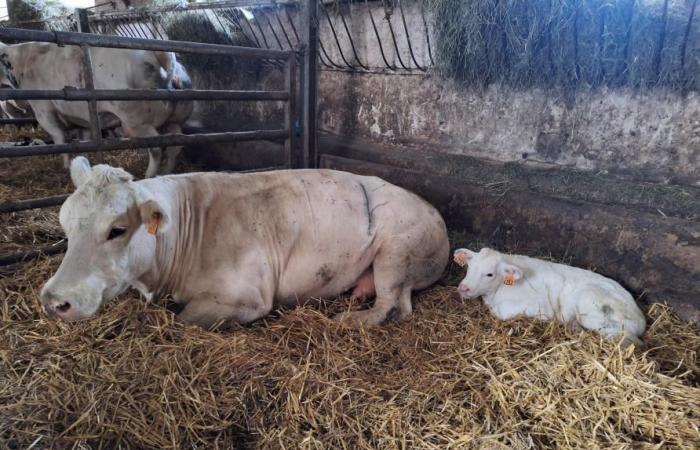It is within the Argenton farm in Lonzée (Gembloux) that the Beef Days were held. A farm with an exceptional character, located in a former abbey dating back to 1100. This is where the 500 Belgian Blue cattle of Philippe and his son Charles Van Eyck live. Each year, those who wear the hats of breeders, breeders and fatteners count around 200 calvings. And on this rainy September day, they agreed to open the doors of their estate for this event dedicated to beef cattle, and to share their expertise in connected breeding management!
Indeed, these two farmers have taken the step of innovation to better manage their animals. “I have been using Ariane for 30 years, a herd management program in which I encode all the data. I am one of the first breeders to have adopted it, and I have followed its entire evolution, moving from the computer to the smartphone. I use this platform all day long. As soon as I see an animal, I record its tag number and I obtain all the information: its condition, its calvings, its age, etc. I am also connected to my@wenet to obtain information directly”. In short, a real digital identity card for animals in just a few clicks.
To detect their heat…
Furthermore, the farmer did not stop there since he decided to add another string to his bow three years ago, with the SenseHub collars from Inovéo. Its main objective? To detect heat. “We have 50 collars, connected to a transmitter. I receive all the information directly on my phone,” continues Philippe Van Eyck. This collar thus analyzes all the zootechnical data (movements, rumination, etc.). As soon as a difference is detected, the tool alerts the farmer, who can then know if his animal is in heat or in poor health.
“By checking these messages once or twice a day, I can track all the cows that are collared and I can plan for insemination.” Once the cows are diagnosed as pregnant via an ultrasound scan at five weeks, the collar is removed and used on another female. “It takes about ten days for it to study the new cow before it can pass on the information.”
Surprised by the reliability of these tools
The Argenton farm is a mixed crop-livestock operation. In terms of crops, there are potatoes (production of seedlings), cereals, corn and beets. Vegetables are also grown there (beans, spinach and broad beans), thanks to the installation of an irrigation network. “These represent periods of intense work, and during these days, we obviously have less time to devote to observing the herd. “Now, systems can monitor animals without me being there. What an advantage!” explains Philippe Van Eyck.
In addition, this breeder assures that he has full confidence in these innovations, which have become indispensable on the farm. “I was surprised by the reliability of the systems. They work on all cattle.”
Father and son are also banking on genomics, which, according to Awé, is attracting more and more professionals. This selection uses the information contained in the DNA of the animals, combined with the pedigree and performance to estimate the genetic potential. Today, several genomic indexes already exist for various criteria (carcass weight, fertility, age at first calving, morphology, etc.), and others could soon see the light of day, such as maternal abilities or feed efficiency.
“We are among the pilot farms. We helped Awé to collect all the data and, in return, it provides us with genomic information on our herd. Since we have been operating this way, it is unthinkable for us to do otherwise. The results are there,” concludes Philippe Van Eyck, also a user of the mating advice software available on the Breeders’ Association platform.
A milestone to reach
Of course, all these tools come at a cost. For example, expect to pay €39 for genotyping a female and €88 for a male. So, is it worth it? For the Argenton farm, it’s worth the effort. And they’re not the only ones to think so, since other breeders have decided to take advantage of the event to embark on the digital adventure.
Among the 260 participants at the Beef Days was Bernard Scohiez, owner of a Belgian Blue Farm in Leuze-en-Hainaut. “I came today to get more information about heat detection collars. I have been learning about them since the Libramont Fair.” Now convinced, he will soon be equipping his cows with this equipment.







